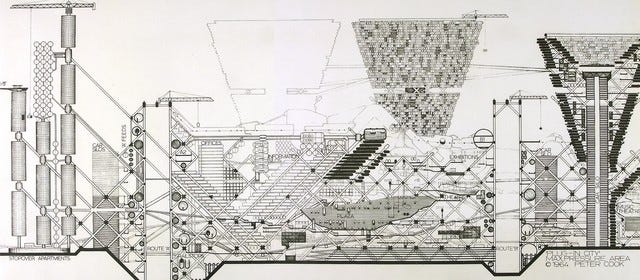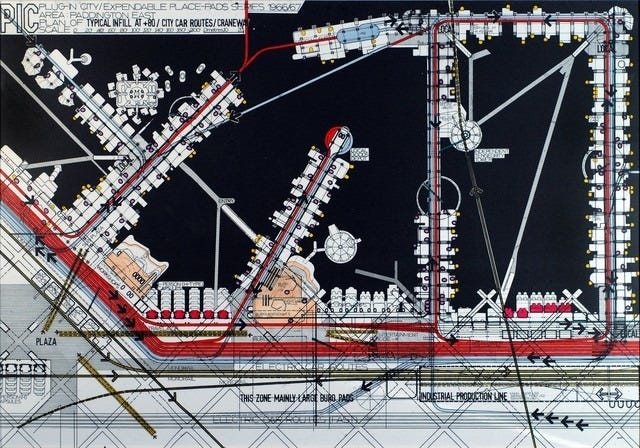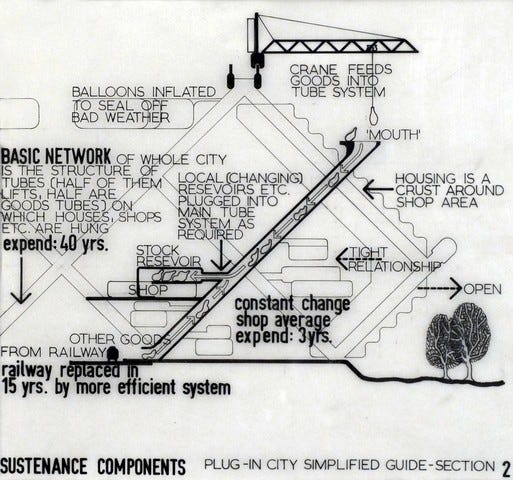The Unbuilt Revolution: Archigram and the Visionary Plug-In City
How Radical Ideas and Paper Architecture Redefined the Boundaries of Urban Design
What if cities could evolve, adapt, and breathe—just like living organisms?
Archigram dared to dream it, and their visionary projects still challenge us to rethink the very essence of urban design.
Before studying architecture, I saw the field in black and white. Buildings were either constructed or they weren't—no in-between. Philosophy, art, concepts, narratives, and manifestos seemed alien, tangential, and frankly unnecessary to the process of building. Architecture, to me, was about pragmatism, not abstraction. That narrow perspective, as I now realize, was naive. Over time, I discovered the rich interplay between these disciplines, and I began to see architecture in shades of grey—a spectrum where the built environment converges with unbuilt ideas.
One of the most profound encounters on this journey was with Archigram, a radical collective that has never constructed a single building. Yes, you read that right: not one. Yet, their impact on architectural thought reverberates through the decades, arguably louder now than in their prime. Founded by Peter Cook, Warren Chalk, Ron Herron, Dennis Crompton, Michael Webb, and David Greene, Archigram was a studio of provocateurs, not builders. They questioned the status quo and proposed visions that redefined architecture’s potential.
Their medium wasn’t steel or concrete but paper and imagination. Their projects were not plans for immediate construction but speculative provocations designed to stir debates. Mixing consumerism, constructivism, pop culture, technology, and transience, they sought to ignite dialogue. Even their name—Archigram—derived from "architectural telegram," signifying architecture as a medium to send powerful messages.
Plug-In City: A Radical Manifesto
Of all their visionary projects, the Plug-In City stands out as both a manifesto and a challenge to conventional urbanism. Peter Cook envisioned a megastructure where prefabricated units—homes, theaters, offices, plazas—plugged into a vast framework. A network of cranes would perpetually adapt the city by removing or relocating modules as needed, ensuring constant evolution.
At first glance, Plug-In City is a utopian fantasy, but beneath its striking visuals lies a profound critique of permanence in architecture. Cook argued that prefabrication could be playful and liberating, a dynamic response to the needs of its users rather than a static imposition. In many ways, this idea aligns with Gilles Deleuze’s theory of becoming—an endless process of transformation—translated into architectural form.
The project reimagined infrastructure as the backbone of adaptability. Within its massive grid, life unfolded in layers: travelators and lifts connected modular units, while car silos and apartment blocks were integrated into towering nodes. Below ran trains; above, cranes hovered like giant mechanical overseers. This urban ecosystem, designed for obsolescence, was as much about its dismantling as its assembly—a city constantly renewing itself to meet changing demands.
Breaking Free from Modernism
“Architecture could break out of its narrow mindedness if it acquired elements (vocabulary of form) from outside itself.”
Peter Cook
Plug-In City was not just a playful exercise in futurism; it was a bold rejection of the rigidity of modernist architecture. Cook’s call for architecture to “break out of its narrow-mindedness” and incorporate forms and ideas from outside its own vocabulary was revolutionary. By envisioning a mobile, flexible, and impermanent urban fabric, Archigram challenged the sacred ideals of permanence and order that had dominated architectural thought.
They dared to ask: What if cities could breathe? What if they could respond to the rhythms of their inhabitants, not just in form but in spirit?
Lessons for Today
In an age of climate crises, rapid urbanization, and technological advancements, Archigram’s visions feel strikingly prescient. Plug-In City asks us to reconsider the role of impermanence in design and to embrace adaptability as a virtue, not a compromise. It challenges us to see architecture as a living organism, not a static monument.
This is a reminder that architecture is not just about constructing buildings but constructing ideas. It is about asking uncomfortable questions and imagining answers that may seem impossible. Conceptual projects like Plug-In City are not failures for their lack of realization; they succeed precisely because they provoke. They remind us that dreaming boldly is as important as building practically.
Closing Thoughts
As architects, designers, and thinkers, we are tasked with shaping the future. Archigram's work teaches us that to innovate, we must first imagine beyond what is possible. If their unbuilt dreams can inspire us decades later, what might your own bold ideas contribute to the conversation?
If this exploration of radical architectural thought resonates with you, join me on this journey. I’ll delve into more conceptual projects in the coming weeks—stories that challenge how we see our cities, our spaces, and ourselves. Subscribe to my blog and let’s imagine together.
Because if we can’t dream, how can we build?








